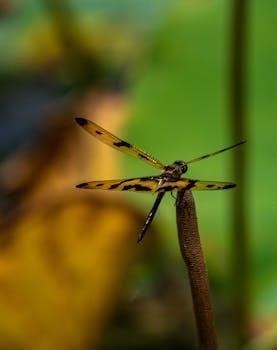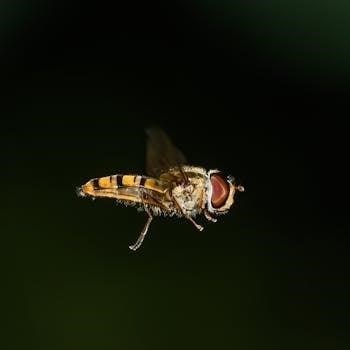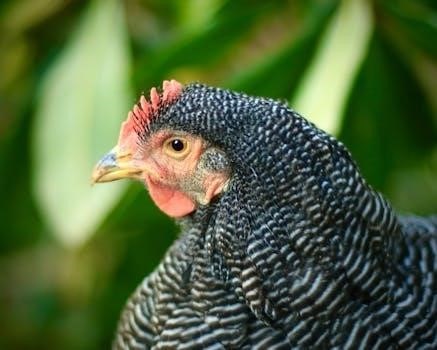Wildlife Biology Core Curriculum⁚ Online and Free Resources
Finding free resources for a wildlife biology core curriculum online can be achieved by exploring open educational materials. These resources are typically available as PDFs. Such resources support wildlife biology and management skills needed for a comprehensive curriculum.
Overview of Wildlife Biology Curriculum
A wildlife biology curriculum provides directed study in wildlife management, techniques, botany, zoology, policy, and ethics. It emphasizes broad training in the biological sciences, with potential specializations. Core concepts include organismal biology, plant ecology/taxonomy, and genetics/evolution. Students learn modern approaches to studying organisms, populations, and ecosystems. The curriculum supports careers in wildlife, fish, and conservation biology. It equips graduates with academic, technical, and experiential training. Students learn to solve complex problems in a changing world.
Core Components of a Wildlife Biology Program
A strong wildlife biology program integrates biological sciences, ecology, and genetics/evolution. These components equip students with a comprehensive understanding for studying organisms, populations, and ecosystems in various environmental contexts, essential for conservation.
Fundamental Concepts in Biological Sciences
Wildlife biology programs emphasize training in fundamental biological sciences, crucial for understanding the specialization areas. These concepts cover biodiversity conservation, physiology, and ecology of plants, animals, and microorganisms. Students define basic principles, including organismal biology, plant ecology/taxonomy, and genetics/evolution. Understanding these concepts allows students to study biological system interactions and changes in aquatic, wetland, and other fields. The curriculum ensures students are equipped with a robust foundation.
Ecology⁚ Plant and Animal Interactions
Ecology is crucial in wildlife biology, focusing on plant and animal interactions within ecosystems; Environmental biology students explore these interactions, examining changes within biological systems across various fields, including aquatic and wetland environments. Understanding these relationships is essential for conserving biodiversity. Students gain experience through field experiments and observations, vital for analyzing ecological data. This knowledge supports conservation efforts and wildlife management practices, preparing students for careers in the field.
Genetics and Evolution
A core curriculum in wildlife biology must include genetics and evolution, focusing on the fundamental principles in biological sciences. Students define and explain basic concepts in genetics and evolution. This includes major concepts in wildlife ecology such as organismal biology, and plant ecology, providing a broad understanding. The curriculum emphasizes broad training in biological sciences. This prepares students for specialization in diverse fields of wildlife, fish, and conservation biology, including veterinary and wildlife health sciences.
Online Courses and Resources for Wildlife Biology
Explore online courses that supplement your certification application. This list offers available resources, but it doesn’t guarantee prior approval. Each application is reviewed individually, ensuring comprehensive evaluation.
Supplemental Online Courses
For students wanting to enhance their wildlife biology education, numerous supplemental online courses are available. These courses offer a breadth of knowledge beyond traditional biology or environmental science majors. They enable a focus on key areas within wildlife biology and management. These resources complement directed study in wildlife management, botany, zoology, policy, and ethics. Online courses provide flexibility, allowing students to deepen their expertise in specific areas of interest, thereby enriching their understanding of wildlife ecology. They also provide valuable experience conducting field experiments, field observations, and sampling.
Free Educational Materials
Numerous free educational materials are available online to support the wildlife biology core curriculum. These resources include lesson plans, produced documentaries, and online books. These materials often cover crucial topics in science and total environment. They are useful for both students and educators. They help promote environmental awareness. These resources provide an overview of ecology and wildlife conservation. Such materials are often divided into sections covering various key concepts. These materials provide the basics of plant and animal ecology. They also provide skills in collecting and handling ecological data, all at no cost.

Degree Requirements and Specializations
Degree requirements in wildlife biology vary. Specializations include Conservation Biology, Fisheries and Aquatic Sciences, and Wildlife Biology. These specializations focus on solving issues related to the sustainability of ecosystems. Academic advisors help understand degree requirements.
Wildlife Biology Concentration
The Wildlife Biology concentration allows students to focus on wildlife biology and management. The program offers directed study in wildlife management techniques, botany, zoology, policy, and ethics. Students explore concepts in wildlife ecology, including population ecology, organismal biology, plant ecology/taxonomy, and genetics/evolution. It requires a strong foundation in biological, physical, and social sciences. Students learn fundamental concepts and modern approaches to studying organisms, populations, and ecosystems, preparing them for careers in wildlife fields.
Fisheries and Aquatic Sciences
Fisheries and Aquatic Sciences is a concentration that allows students to explore the study of aquatic ecosystems. The FWCB major prepares students to manage and conserve populations of fish and wildlife in their natural habitats. Environmental biology students are exposed to concepts of biodiversity conservation, physiology, and ecology of plants, animals, and microorganisms; These programs focus on solving issues related to conservation and sustainability. Students gain valuable experience conducting field experiments, field observations, and sampling in aquatic environments.
Conservation Biology
Conservation Biology is a vital concentration focusing on the preservation and management of biodiversity. Environmental biology students delve into the study of biodiversity conservation, physiology, and ecology of diverse organisms. The curriculum emphasizes solving current and future issues related to conservation and sustainability. Students learn to address complex problems in a changing world, using scientific tools and techniques. This field integrates biological, physical, and social sciences to promote effective conservation strategies. Conservation efforts are crucial for maintaining healthy ecosystems and protecting endangered species.

Skills and Techniques for Wildlife Biologists
Wildlife biologists require hands-on skills and advanced techniques for studying organisms and ecosystems. These skills encompass field experiments, observations, and sampling, which are crucial for managing wildlife populations effectively in natural habitats.
Field Experiments and Observations
Field experiments and observations are fundamental for wildlife biologists, involving direct interaction with ecosystems. These techniques provide valuable experience in conducting field research, assessing environmental changes, and understanding species interactions. Biologists also use these methods to study animal behavior, plant ecology, and the impacts of various factors on wildlife populations. Accurate data collection and analysis during field experiments and observations are crucial for effective conservation and management strategies. Furthermore, these experiences enhance the biologists’ ability to solve complex problems in changing environments, promoting sustainability and biodiversity conservation efforts, which are essential components of their work.
Sampling Techniques
Sampling techniques are essential for wildlife biologists, enabling them to collect data efficiently and accurately in diverse habitats; These techniques involve selecting representative subsets of populations or ecosystems to assess various parameters. Biologists use sampling to study population size, species distribution, habitat quality, and environmental impacts. Effective sampling requires careful planning, appropriate tools, and standardized protocols to ensure data reliability. Modern approaches to studying organisms, populations, and ecosystems are enhanced by the use of proper sampling. These techniques are crucial for informing conservation efforts and management decisions, promoting wildlife sustainability and maintaining biodiversity in changing environments.

Career Paths in Wildlife Biology
A wildlife biology degree leads to diverse career paths. These range from wildlife management and conservation, to research and education. Professionals work to solve complex issues in a changing world.
Wildlife Management
Wildlife management careers focus on maintaining and improving wildlife populations and their habitats. Professionals in this field work with various species, applying ecological principles. They implement strategies for conservation, monitor wildlife health, and address human-wildlife conflicts. Management plans may involve habitat restoration, population control, and regulated hunting. Collaboration with stakeholders is crucial for successful wildlife management. These experts balance the needs of wildlife with human interests, ensuring sustainable coexistence and biodiversity conservation. Effective communication skills and a deep understanding of ecological dynamics are essential for success in this field.
Conservation
Conservation careers revolve around protecting ecosystems and preserving biodiversity for future generations. Professionals engage in habitat restoration, species recovery, and environmental policy advocacy. They address threats like habitat loss, pollution, and climate change through scientific research and practical interventions. Conservation biologists work to maintain ecological integrity, promote sustainable practices, and educate the public. Collaboration with communities, governments, and organizations is vital for effective conservation efforts. They develop strategies to conserve natural resources, manage protected areas, and mitigate human impacts. A passion for nature and a commitment to sustainability are essential for success in this field.

Certification and Professional Designations
Professional certifications, like Certified Wildlife Biologist (CWB), validate expertise and commitment in the field. Certifications can enhance career opportunities and demonstrate a high level of competency. The Wildlife Society offers various certifications for wildlife professionals.
Certified Wildlife Biologist (CWB)
The Certified Wildlife Biologist (CWB) designation is a professional credential offered through The Wildlife Society. It recognizes individuals who have met specific educational, experience, and ethical standards in wildlife biology. Achieving CWB status demonstrates a high level of knowledge and expertise in the field, enhancing career prospects. Candidates must meet rigorous criteria, including a combination of academic qualifications, practical experience, and a commitment to professional development and ethical conduct. It signifies expertise in wildlife management and conservation, showcasing dedication to the profession.
Associate Wildlife Biologist (AWB)
The Associate Wildlife Biologist (AWB) is another professional designation offered by The Wildlife Society. This certification is typically pursued by individuals who are early in their careers. It’s designed for those who have the educational qualifications but are still gaining the necessary field experience required for the Certified Wildlife Biologist (CWB) status. The AWB designation demonstrates a commitment to the profession and a foundational understanding of wildlife biology principles. It serves as a stepping stone toward achieving full certification as a Certified Wildlife Biologist, recognizing their early-career accomplishments and potential.
